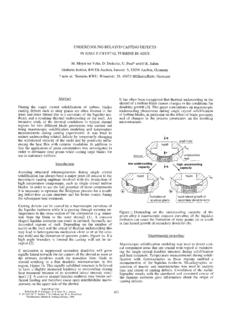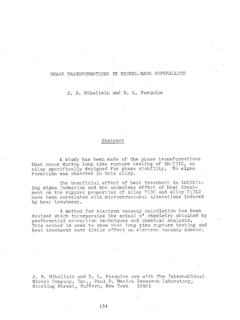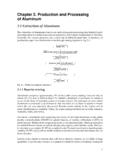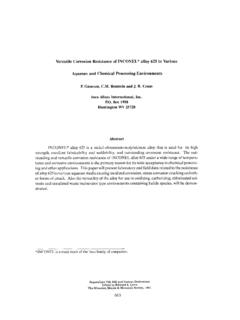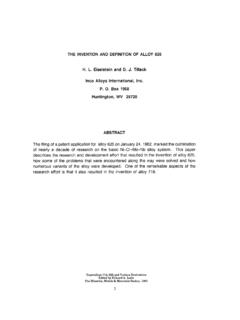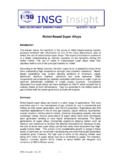Transcription of Improved Single Crystal Superalloys, CMSX …
1 Improved Single Crystal Superalloys, cmsx -4 (SLS)[La+Y] and cmsx -486 Ken Harris, Jacqueline B. Wahl Cannon-Muskegon Corporation [A PCC Company], Box 506, Muskegon, MI 49443-0506 USA Keywords: Single Crystal , Oxidation, Defect Tolerance Abstract Single Crystal superalloys and casting technology offer a combination of attractive properties for advanced gas turbine engine components. The alloys are designed to produce superior properties for a challenging combination of requirements: high temperature creep-strength, fatigue resistance, oxidation resistance, coating performance and retention of performance in thin-walled configurations. Application of this technology to new components has only been restricted by the competing criteria of affordability for first time introduction.
2 The development of Improved Single Crystal superalloys , cmsx -4 (SLS)[La+Y] and cmsx -486 provide an appealing combination of enhanced performance and production affordability for demanding, high temperature applications in advanced gas turbine turbine engine designs require the use of Single Crystal (SX) superalloy turbine airfoil, seal and combustor components to obtain performance and life cycle objectives. The benefits of SX castings have been well documented: Single Crystal alloys offer Improved creep-rupture, fatigue, oxidation and coating properties, resulting in superior turbine engine performance and durability [1,2,3,4,5]. In addition, Single Crystal alloys retain a higher fraction of their thick section rupture life as wall thickness is reduced [6].
3 Due to the attractive combination of properties and performance, applications of Single Crystal technology have been extended to a variety of components with widely divergent requirements. The most stringent applications, such as 1st stage turbine blades, require optimum high temperature properties and the use of highly reactive element additions, such as La and Y, ideally without the expense of non-reactive (alumina/yttria) foundry ceramics. Complex configurations, such as multi-vane segments and large industrial gas turbine (IGT) airfoils, require generous grain specifications to obtain the high manufacturing yields necessary for meeting cost objectives. This paper will discuss the development of two Improved Single Crystal superalloys , cmsx -4 Super Low Sulfur (SLS)[La+Y] and cmsx -486 [7], which were driven by the industry call for advanced technology SX castings at affordable production costs.
4 _____CMSX-4 , cmsx -486 , CM 186 LC , CM 247 LC , cmsx -3 and cmsx are registered trademarks of the Cannon-Muskegon CorporationCMSX-4 (SLS)[La + Y] Alloy BackgroundCMSX-4 is a second generation, Re-bearing nickel-base SX superalloy which has been extensively investigated and documented in the literature [3,4,8,9,10]. The nominal chemistry is provided in Table I. cmsx -4 alloy has been successfully used in numerous aero and industrial gas turbine applications since 1991. These applications, such as high pressure turbine blades and seals, have demonstrated an impressive combination of high temperature strength, good phase stability and oxidation, hot corrosion and coating performance in extensive engine service [11,12,13].
5 Close to five million pounds (650 heats) of cmsx -4 alloy have been manufactured to date. Table I. cmsx -4 Alloy Nominal Composition Element Element Wt% Cr Al Co Ti W Ta Re 3 Hf Mo Ni Balance cmsx -4 [La+Y] alloy was subsequently introduced to meet ever-increasing engine design requirements for hot section turbine components.
6 Of particular interest was improvement in bare alloy oxidation performance to minimize blade tip and internal oxidation and improve thermal barrier coating (TBC) adherence. Evaluation of reactive element additions demonstrated the oxidation behavior of bare cmsx -4 alloy (sulfur content d2 ppm) could be dramatically Improved by the addition of lanthanum (La) and yttrium (Y) (Figure 1) [14]. Figure 1. 1093qC (2000qF) Dynamic Cyclic Oxidation Test Results for Bare cmsx -4 Alloy with and without Reactive Element Additions 45 superalloys 2004 Edited by Green, Pollock, H. Harada,TMS (The Minerals, Metals & Materials Society), Howson, Reed, Schirra, and S, WalstonIt was also shown that control and retention of reactive element additions was Improved when a combination of La and Y were used, compared to either element individually.
7 However, realization of these improvements for turbine components was dependant upon the use of expensive, non-reactive alumina or yttria core materials [14]. It should also be noted that, in addition to being more costly, core materials such as alumina are much more difficult to remove following casting, resulting in long, expensive autoclave processing. New DevelopmentsCMSX-4 (SLS)[La+Y] alloy is an Improved version of cmsx -4 which is pre-alloyed with La and Y and has consistent low sulfur content of 1 ppm. Initial development work included production of several R&D-size heats on the Cannon-Muskegon (CM) V-5 250 lb. vacuum induction melting (VIM) furnace to demonstrate 1 ppm sulfur content capability and La + Y control.
8 Subsequently, the manufacturing technology was scaled to 4000 lb. heats on the CM V-6 VIM furnace without negative impact on critical heat chemistry (Table II). cmsx -4 (SLS)[La+Y] has excellent alloy cleanliness in terms of stable oxide inclusions, as represented by 1-2 ppm oxygen content over multiple heats. Table II. cmsx -4 (SLS)[La+Y] Production Heats Critical Chemistry Heat La ppmYppmSppmMgppmZrppmSi[N] ppm[O] ppm5V0114 363 339 1 <180 <10 <.01 1 2 5V0115 500 490 1 <180 <10 .01 1 2 5V0128 430 410 1 <180 <10 <.01 1 2 6V2451 142 142 1 <180 <10 <.
9 01 1 1 6V2461 747 620 1 <180 14 .01 1 2 The highly reactive elements La and Y tie up the residual sulfur in the alloy as stable La+Y sulfides, preventing the migration/diffusion of sulfur to the free surface. Sulfur segregation has been shown to destroy the strong Van der Waals bond between the D alumina scale layer and the base alloy/coating/bond coat, resulting in premature coating/TBC spallation [15,16,17,18]. Figure 2. Surface Microstructure on cmsx -4 (~39 ppm La+Y) following 1389 hours creep-rupture testing at 1050qC/125 MPa (1922qF/18 ksi) [Courtesy Rolls-Royce plc] An example of the benefit of La + Y additions is shown in the remarkable surface microstructure observed following creep-rupture testing at 1050qC (1922qF) (Figure 2) [19].
10 After 1389 hours there was an 8 micron thick, 2-layer oxide film and no evidence of gamma prime depletion at all. Without the La+Y addition, significant J depletion would be expected from extended exposure at this temperature. This behavior translates to substantial improvement to EB-PVD TBC life, as demonstrated in (Figure 3) [20]. cmsx -4 + CeCMSX-4 + LaCMSX-10K Relative LifeFigure 3. Reactive Element Effects on EB-PVD TBC Life 1093 C (2000 F)/10 hr Thermal Exposure Cycles [Courtesy Solar Turbines] BenefitsCasting trails with pre-alloyed cmsx -4 (SLS)[La+Y] ingot have demonstrated Improved control and retention of La+Y content compared to traditional Ni-foil-wrapped add packets attached to the charge increment at the casting furnace.
